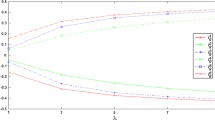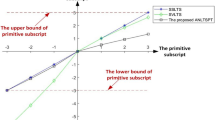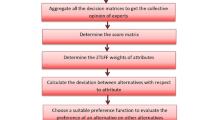Abstract
Multiple-criteria decision-making is common in our daily life. The probabilistic linguistic term set is an effective tool to represent both simple and cognitive complex linguistic expressions given by individuals and groups completely. In this paper, the PROMETHEE (Preference Ranking Organization METHod for Enrichment Evaluations) is enhanced by integrating with a conflict analysis to solve general multiple-criteria decision-making problems with both quantitative and qualitative criteria. Firstly, to capture the inherent uncertainty of evaluations, interval numbers are used to expresses the values of quantitative criteria while probability linguistic term sets are used to scale the qualitative criteria. Then, a preference function for both quantitative and qualitative criteria is proposed. In addition, a conflict analysis is presented and added to the PROMETHEE, which can derive the preference, indifference, and incomparability (PIR) relations of alternatives. A reference point is given to select the thresholds for the PIR relations. Finally, the improved PROMETHEE is highlighted by a case study concerning site selection of the wind power plant.


Similar content being viewed by others
References
Zadeh LA. The concept of a linguistic variable and its application to approximate reasoning-part I. Inf Sci. 1975;8(3):199–249.
Xu ZS. Uncertain linguistic aggregation operators based approach to multiple attribute group decision making under uncertain linguistic environment. Inf Sci. 2004;168(1–4):171–84.
Rodríguez RM, Martínez L, Herrera F. Hesitant fuzzy linguistic terms sets for decision making. IEEE Trans Fuzzy Syst. 2012;20:109–19.
Liao HC, Xu ZS, Zeng XJ, Merigó JM. Qualitative decision making with correlation coefficients of hesitant fuzzy linguistic term sets. Knowl-Based Syst. 2015;76:127–38.
Liao HC, Wu XL, Liang XD, Yang JB, Xu DL, Herrera F. A continuous interval-valued linguistic ORESTE method for multi-criteria group decision making. Knowl-Based Syst. 2018;153:65–77.
Pang Q, Wang H, Xu ZS. Probabilistic linguistic term sets in multi-attribute group decision making. Inf Sci. 2016;369:128–43.
Wu XL, Liao HC. An approach to quality function deployment based on probabilistic linguistic term sets and ORESTE method for multi-expert multi-criteria decision making. Inf Fusion. 2018;43:13–26.
Zhang YX, Xu ZS, Wang H, Liao HC. Consistency-based risk assessment with probabilistic linguistic preference relation. Appl Soft Comput. 2016;49:817–33.
Liao HC, Jiang LS, Xu ZS, Xu JP, Herrera F. A linear programming method for multiple criteria decision making with probabilistic linguistic information. Inf Sci. 2017;415:341–55.
Liao HC, Xu ZS, Herrera-Viedma E, Herrera F. Hesitant fuzzy linguistic term set and its application in decision making: a state-of-the art survey. Int J Fuzzy Syst. 2018;20(7):2084–110.
Chen SJ, Hwang CL. Fuzzy multiple attribute decision making: methods and applications. Berlin: Springer Verlag; 1992.
Opricovic S. Multicriteria optimization of civil engineering systems. Belgrade: Faculty of Civil Engineering; 1998.
Liao HC, Wu XL. DNMA: a double normalization-based multiple aggregation method for multi-expert multi-criteria decision making. Omega. 2019. https://doi.org/10.1016/j.omega.2019.04.001.
Brauers WKM, Zavadskas EK. Project management by MULTIMOORA as an instrument for transition economies. Technol Econ Dev Econ. 2010;16(1):5–24.
Liao HC, Qin R, Gao CY, Wu XL, Hafezalkotob A, Herrera F. Score-HeDLiSF: a score function of hesitant fuzzy linguistic term set based on hesitant degrees and linguistic scale functions: an application to unbalanced hesitant fuzzy linguistic MULTIMOORA. Inf Fusion. 2019;48:39–54.
Pamucar D, Petrovic I, Cirovic G. Modification of the best-worst and MABAC methods: a novel approach based on interval-valued fuzzy-rough numbers. Expert Syst Appl. 2018;91:89–106.
Vesković S, Stević Ž, Stojić G, Vasiljević M, Milinković S. Evaluation of the railway management model by using a new integrated model DELPHI-SWARA-MABAC. Decis Mak Appl Manag Eng. 2018;1(2):34–50.
Bozanic D, Tešić D, Kočić J. Multi-criteria FUCOM – fuzzy MABAC model for the selection of location for construction of single-span bailey bridge. Decis Mak Appl Manag Eng. 2019;2(1):132–46.
Keshavarz Ghorabaee M, Zavadskas EK, Turskis Z, Antucheviciene J. A new combinative distance-based assessment (CODAS) method for multi-criteria decision-making. Econ Comput Econ Cybern Stud Res. 2016;50(3):25–44.
Pamucar D, Mihajlovic M, Obradovic R, Atanaskovic P. Novel approach to group multi-criteria decision making based on interval rough numbers: hybrid DEMATEL-ANP-MAIRCA model. Expert Syst Appl. 2017;88(1):58–80.
Chatterjee K, Pamucar D, Zavadskas EK. Evaluating the performance of suppliers based on using the R’AMATEL-MAIRCA method for green supply chain implementation in electronics industry. J Clean Prod. 2018;184:101–29.
Roy B. Classement et choix en presence de points de vue multiples (La methode ELECTRE). RIRO. 1968;2(8):57–75.
Roubens M. Preference relations an actions and criteria in multicriteria decision making. Eur J Oper Res. 1982;10(1):51–5.
Liao HC, Wu XL, Liang XD, Xu JP, Herrera F. A new hesitant fuzzy linguistic ORESTE method for hybrid multi-criteria decision making. IEEE Trans Fuzzy Syst. 2018;26(6):3793–807.
Brans JP, Vincke P. A preference ranking organisation method (the PROMETHEE method for multiple criteria decision making). Manag Sci. 1985;31:647–56.
Behzadiana M, Albadvi A, Aghdasi M. PROMETHEE: a comprehensive literature review on methodologies and applications. Eur J Oper Res. 2010;200(1):198–215.
Huylenbroeck GV. The conflict analysis method: bridging the gap between ELECTRE, PROMETHEE and ORESTE. Eur J Oper Res. 1995;82(3):490–502.
Brans, J.P. L’ingénièrie de la décision; Elaboration d’instruments d’aide à la décision. La méthode PROMETHEE. In R. Nadeau and M. Landry, editors, L’aide à la décision: Nature, Instruments et Perspectives d’Avenir Québec, Canada. Presses de l’Université Laval, 1982, 183–213.
Brans JP, Mareschal B. PROMETHEE V-MCDM problems with segmentation constraints. INFOR. 1992;30:85–96.
Brans JP, Mareschal B. The PROMETHEE VI procedure: how to differentiate hard from soft multicriteria problems. J Decis Syst. 1995;4:213–23.
Macharis C, Brans JP, Mareschal B. The GDSS PROMETHEE procedure–a PROMETHEE-GAIA based procedure for group decision support. J Decis Syst. 1998;7:283–307.
Liao HC, Xu ZS. Multi-criteria decision making with intuitionistic fuzzy PROMETHEE. J Intell Fuzzy Syst. 2014;27(4):1703–17.
Govindan K, Kadziński M, Sivakumar R. Application of a novel PROMETHEE-based method for construction of a group compromise ranking to prioritization of green suppliers in food supply chain. Omega. 2017;71:129–45.
Park D, Kim Y, Um MJ, Choi SU. Robust priority for strategic environmental assessment with incomplete information using multi-criteria decision making analysis. Sustainability. 2015;7(8):10233–49.
Li J, Wang JQ. Multi-criteria outranking methods with hesitant probabilistic fuzzy sets. Cogn Comput. 2017;9(6):1–15.
Liu PD, Tang GL. Multi-criteria group decision-making based on interval neutrosophic uncertain linguistic variables and Choquet integral. Cogn Comput. 2016;8(6):1036–56.
Ye J. Multiple attribute decision-making methods based on the expected value and the similarity measure of hesitant neutrosophic linguistic numbers. Cogn Comput. 2018;10(3):454–63.
Tian ZP, Wang J, Wang JQ. A likelihood-based qualitative flexible approach with hesitant fuzzy linguistic information. Cogn Comput. 2016;8(4):670–83.
Liao HC, Wu XL. Probabilistic linguistic MULTIMOORA: a multi-criteria decision making method based on the probabilistic linguistic expectation function and the improved Borda rule. IEEE Trans Fuzzy Syst. 2018;26(6):3688–702.
Wu XL, Liao HC. A consensus-based probabilistic linguistic gained and lost dominance score method. Eur J Oper Res. 2019;272(3):1017–27.
He YD, He Z. Extensions of Atanassov’s intuitionistic fuzzy interaction Bonferroni means and their application to multiple attribute decision making. IEEE Trans Fuzzy Syst. 2016;24(3):558–73.
He YD, He Z, Chen HY. Intuitionistic fuzzy interaction Bonferroni means and its application to multiple attribute decision making. IEEE Trans Cybern. 2015;45(1):116–28.
Shen JF. Wind power project development and evaluation. Economist. 2009;5:55–6.
Zuo Y, Liu H. Evaluation on comprehensive benefit of wind power generation and utilization of wind energy. In Proceedings of the ICSESS 2012—Proceedings of 2012 IEEE 3rd International Conference on Software Engineering and Service Science, Beijing, China, 22–24 June 2012; Volume 31, pp. 635–8.
Rehman AU. An approach to evaluating alternatives for wind power plant locations. S Afr J Ind Eng. 2016;27(4):153–65.
Wu Y, Geng S. Multi-criteria decision making on selection of solar–wind hybrid power station location: a case of China. Energy Convers Manag. 2014;81:527–33.
Mi XM, Tang M, Liao HC, Shen WJ, Lev B. The state-of-the-art survey on integrations and applications of the best worst method in decision making: why, what, what for and what’s next? Omega. 2019;87:205–25.
Pamučar D, Gigović L, Bajić Z, Janošević M. Location selection for wind farms using GIS multi-criteria hybrid model: an approach based on fuzzy and rough numbers. Sustainability. 2017;9(8):1315.
Funding
The work was supported by the National Natural Science Foundation of China (71771156, 71971145), the 2019 Sichuan Planning Project of Social Science (No. SC18A007), the 2018 Key Project of the Key Research Institute of Humanities and Social Sciences in Sichuan Province (No. Xq18A01, No. LYC18-02), the Project of Innovation at Sichuan University (No. 2018hhs-43) and the Graduate Student's Research and Innovation Fund of Sichuan University (No. 2018YJSY039).
Author information
Authors and Affiliations
Contributions
The research is designed and performed by Xingli Wu, Cheng Zhang, and Huchang Liao. The data was collected and analyzed by Xingli Wu and Cheng Zhang. The paper is written by Xingli Wu, Cheng Zhang, and Huchang Liao and is finally checked and revised by Lisheng Jiang. All authors read and approved the final manuscript.
Corresponding author
Ethics declarations
Conflict of Interest
The authors declare that they have no conflict of interest.
Ethical Approval
This article does not contain any studies with human participants or animals performed by any of the authors.
Informed Consent
As this article does not contain any studies with human participants or animals performed by any of the authors, the informed consent in not applicable.
Additional information
Publisher’s Note
Springer Nature remains neutral with regard to jurisdictional claims in published maps and institutional affiliations.
Rights and permissions
About this article
Cite this article
Wu, X., Zhang, C., Jiang, L. et al. An Integrated Method with PROMETHEE and Conflict Analysis for Qualitative and Quantitative Decision-Making: Case Study of Site Selection for Wind Power Plants. Cogn Comput 12, 100–114 (2020). https://doi.org/10.1007/s12559-019-09675-7
Received:
Accepted:
Published:
Issue Date:
DOI: https://doi.org/10.1007/s12559-019-09675-7




